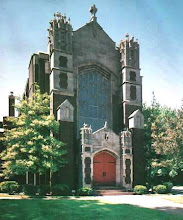
This Sunday will demonstrate my usual goal of incoporating music from a wide variety of styles. The service has some of the greatest hymns from the ELW, including "At the Lamb's High Feast We Sing" and "On Our Way Rejoicing," the latter of which will include a choir descant on verse two.
The prelude will be Passcaglia in d minor by Buxtehude. I hope that's a name that is becoming familiar by now. This particular piece is built on a simple 7-note ostinato bass. An ostinato is a short phrase that is repeated throughout the piece, much like a canon. Pachelbel's Canon in D is familiar to most people, of course, and you can probably think of how that piece involves a repeated chord progression.
The Passacaglia in d minor represents Buxtehude's interest in symbolic numerology (an interest he shared with Bach and many other notable men and women of their era). The 7 note ostinato takes up 4 bars and occurs 28 times over the course of the piece. Overall, the structure modulates into 4 different keys, each of them for 28 bars. I've heard it described both as a tribute to Mary and as symbolic of the phases of the moon.
The choir's anthem, titled "Go, Ye, Into All the World," is composed in an entirely different style, with a driving rock beat (or at least as rock-like as a traditional ELCA service normally gets!). The song alternates between an up-tempo chorus that encourages us to "Spread the Gospel to every people" and lyrical verses. Overall, the text is based on Christ's "Great Commission." Not only is it a great piece of music on its own, but it also provides the perfect contrast to the Baroque prelude.


I still think we should shove a mic into the harpsichord or do it with the MIDI and all wear powdered wigs. That'd be the perfect union.
ReplyDelete